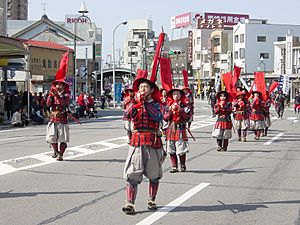Ashigaru facts for kids
Ashigaru were a special kind of Japanese soldier. They first appeared a long time ago, during Japan's Heian Period (794-1185). At first, they worked as bodyguards for important government leaders. Over many years, they became more active in wars. They eventually served as foot soldiers for powerful samurai warriors and the shogun, who was like a military ruler of Japan.
After the Edo Period (1603-1868) began, many ashigaru no longer had masters to serve. Some of these former soldiers later became police officers.
Contents
What Ashigaru Wore and How They Fought
Ashigaru soldiers were known for their clever fighting methods. They often used surprise attacks and worked together in groups. This helped them win battles.
Their Armor and Weapons
Ashigaru wore special armor to protect themselves. This armor was made from metal, leather, and even strong Japanese rice paper. They also wore a gauntlet, which protected their hand and wrist. A Japanese half-length coat was also part of their uniform.
For weapons, ashigaru used many different kinds. They might carry a sword, a long spear, a gun (like a matchlock), or a bow and arrows. Besides their weapons, they also carried useful items for long journeys. These included a water bottle, tissue paper, and rice for food.
The Ōnin War and Ashigaru Reputation
During the Ōnin War (1467-1477), ashigaru soldiers were involved in some difficult events. They were known for robbing and looting the city of Kyoto. Because of this, some people started to see ashigaru as undisciplined troops.
Images for kids
-
Edo-period single-piece breastplate hara-ate dō. Lacquered iron plates with cloth back strap.
-
Edo-period Kabuto helmet of the zunari style, plain with no front crest holder
-
Edo-period karuta zukin, an armored hood from with iron cards and mail
-
Edo-period karuta tatami dō in the hara-ate style
-
Edo-period kikko tatami dō. A collapsible cuirass made with small hexagonal iron plates.
See also
 In Spanish: Ashigaru para niños
In Spanish: Ashigaru para niños











